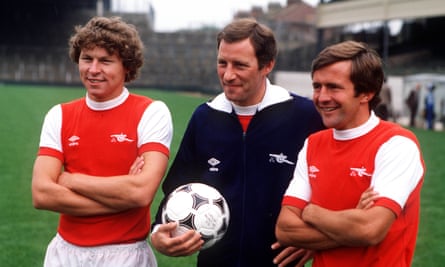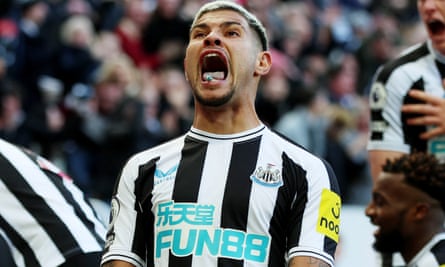“The reborn and now renamed Bury FC will play at Gigg Lane next season, around 221 weeks since Bury’s last competitive game at the ground, against Port Vale in May 2019,” writes David Triggs. “Will this be the longest gap between a team playing two home games at the same stadium?”
Four years is a helluva long time in football, but it’s nowhere near the longest gap between home games at the same stadium. Let’s start with a famous groundshare from the 1980s: “Charlton Athletic moved from the Valley after a 2-0 win over Stoke City on 21 September 1985 – Rob Lee scored the winning goal – and returned after more than seven years’ exile at Selhurst Park and Upton Park,” writes Michael Haughey. “They celebrated their return to the Valley with a 1-0 win over Portsmouth on 5 December 1992.”
It’s a while since the Luftwaffe were last mentioned in the Knowledge, but this question is right up their street. “Despite being requisitioned by the military and being a bit bombed by the Luftwaffe, Old Trafford was still used by Manchester United (on and off) until 8 March 1941, when they beat Bury 7-3 in a War League game,” notes Jim Hearson. “Three days later, the bombers came back and pretty much finished the job, causing United to share with City for a while. I say a while, their first game back was on 24 August 1949, some 428 weeks after their last.”
Duncan Richer has tweeted about England, who had a nine-year, three-day gap between competitive matches at Wembley from 1938 to 1947*. This one needs the asterisk, as England played internationals at Wembley throughout the war. But they were all unofficial games, either War-Time or Victory Internationals. England went six years and seven months between internationals at Wembley while the new stadium was being built between 2000 and 2007. It was six years and 11 months between competitive games.
John Brewin checks in: “Juventus and Torino started to play in the new-build Stadio Delle Alpi in May 1990. They then both returned to their previous Stadio Communale, now called the Stadio Olimpico (after the Turin Winter Olympics of that year) in 2006, while the Juventus Stadium was built on the site of the unloved Delle Alpi and opened in 2011. Torino stayed on in the Olimpico. That first May 1990 game at the cavernous Delle Alpi was when a joint Juve–Torino team defeated Porto 4–3. The first competitive game back at the old Communale saw Torino, up in Serie A, draw 1-1 with Parma on 10 September 2006. The next week, Juve, relegated to Serie B after the Calciopoli scandal, beat Piacenza 2-1, David Trezeguet and Alessandro del Piero getting the goals. So that’s 16 years and four months.”
Next, to Colombes in France.
@TheKnowledge_GU Gap between home games: Racing Club de France went from 1985 to 2012 without playing at State Yves-du-Manoir.
— The Cheapskate 🥔 🃏 🗑️ 🐼 (@CheapskateShow) June 14, 2023
But the best answer we have received so far comes from west London. “Queens Park Rangers went more than 29 years between home games at White City Stadium,” writes Alun Thomas. “They ended the 1932-33 season with a home game against Torquay on 6 May, and finally returned against Notts County on 6 October 1962. They also had a 19-year gap between using the stadium in 1912 and the start of the 1931-32 season.”
You wonder to yourself …
“Which player has played for the most clubs in places name-checked in Panic by the Smiths?” tweets Kris Foster.
Panic was released in the summer of 1986, reaching No 11 on the hit parade. It’s best known for the repeated lyric “Hang the DJ” – later co-opted by Manchester United fans to extol the great Eric Djemba-Djemba – but at the start of the song Morrissey lists a number of places where there is panic on the streets – London, Birmingham, Carlisle, Dublin, Dundee and Humberside – with Leeds and Grasmere mentioned in slightly different context. And he also cites “provincial towns that you jog round”, an ostensibly meaningless aside that will make more sense when (or if) you read the next paragraph.
“The best I could find was Nick Barmby,” writes Nick Williamson. “He played for Hull (Humberside), Leeds, Spurs (London) and Middlesbrough (a provincial town).”
We’re going to be really boring and disqualify Middlesbrough, which puts Barmby on three clubs, but Hannah Williamson can go one better. “Some that manage to reach four clubs are Jermaine Beckford (began his senior career at Wealdstone in London, before moving to Leeds, as well as spending time on loan at Carlisle and Scunthorpe in Humberside); Robert Snodgrass (had a four-year spell at Leeds and a three-year spell on Humberside with Hull before moving to West Ham in London, while also spending time on loan at Aston Villa in Birmingham); and Marlon King (began his career in London with Barnet, later had loan spells with Leeds and Hull, as well as a spell with Birmingham later in his career).

“I’m sure there’s someone who’s managed to hit five or more,” continues Hannah, “but I’ve already put too much time into researching this so hopefully someone other than me can find a better answer.” That’s what Team Knowledge is here for. It’s maybe not entirely in the spirit of the question, but Scott Parker played for five different London clubs: Charlton, Chelsea, West Ham, Spurs and Fulham. And that particular loophole can only lead us to one man.
“Clive Allen has to be in with a shout,” tweets MSJM. “Seven different London teams and Carlisle United.”

Photograph: Bob Thomas/Bob Thomas Sports Photography/Getty Images
Those London clubs, since you asked so politely, were QPR, Arsenal (Allen did play for them during his 62-day stay, though only in friendlies), Crystal Palace, Spurs, Chelsea, West Ham and Millwall. Oh, and the London Monarchs, but they don’t count. So, Clive Allen has a Panic score of eight. If you can beat it, you know what to do.
Dida’s diverse delights
“After adding a treble with Manchester City to the World Cup with Argentina, Júlian Álvarez has now won 12 trophies – each in a different tournament – at the age of 23,” writes Niall McVeigh. “Are there any other players with such a diverse honours list?”
No surprise that the best answer to this question is another South American player who collected multiple honours at home and then moved to Europe. “Although not as quickly as Álvarez, the former Brazilian goalkeeper Dida collected an impressive and diverse trophy cabinet by the age of 30,” writes Dirk Maas. Here’s the full list:
-
Copa de Oro 1995
-
Copa do Brasil 1996 and 2002
-
Copa Libertadores: 1997
-
Fifa Confederations Cup: 1997
-
Copa América: 1999
-
Campeonato Brasileiro Série A: 1999
-
Fifa Club World Cup: 2000
-
Torneio Rio–São Paulo: 2002
-
Fifa World Cup: 2002
-
Uefa Champions League: 2003
-
Coppa Italia: 2003
-
Uefa Super Cup: 2003
-
Serie A: 2004
-
Supercoppa Italiana: 2004

Foreign cup triumphs (2)
In last week’s Knowledge we looked at teams winning competitions in other countries or regions. And we forgot a biggie. “You missed Cardiff City being the only non-English side to win the English FA Cup, in 1927,” writes Neil Smith. “When I was young I admired an oil painting in Cardiff Central Library of the ball slipping off the Arsenal goalie’s new shirt and into the net, the only goal of the match. Ever since then the Arsenal goalie has worn a used jersey. My grandfather was in attendance.”
“Mexican teams competed with some degree of success in the South American club competitions for 16 years from 2000,” adds Duncan Kesseler. “Many reached finals, but the only winner was Pachuca, who defeated Colo Colo 3-2 on aggregate in the final of the 2006 Copa Sudamericana (the South American Europa League …).”
And finally …
St Mirren won an Epsom Cup in Singapore in 1987.
They also won the Barcelona Cup at the Camp Nou, Les Corts, beating Notts County in the final in 1922.— Stuarty Mc (@stuchastosh) June 14, 2023
Knowledge archive
“Have Scotland ever been higher than England in the Fifa rankings and, if not, what’s the closest the two nations have come?” wondered Colin Young in 2007.
The answer was yes, Colin. Scotland’s sole month when they were ahead of their old rivals came in June 1995, when they ranked 21st with England 22nd. At the time of writing, the Scots are enjoying their highest ever ranking (13th), a far cry from their hapless form of 2005, when they plunged to a record low of 88th. England’s best effort is a respectable fourth, which they achieved as recently as 2006, while their worst performance sent them dropping to 27th in 1996.
[Note: Scotland haven’t been above England since this question was asked 16 years ago, though they came very close in the summer of 2008.]
Can you help?
“Scotland’s comeback against Norway was the first time since 1889 they had won a game after trailing with 10 minutes to go. Surely that 134-year gap is a record,” ponders Stevy Toal.
“It amazes me that elite footballers are still regularly seen chewing gum during matches,” writes Gregg Bakowski. “Isn’t it a choking hazard? Or is there a psychological or physiological benefit to it that I’ve clearly missed?”

“Watching the Croatia-Spain Nations League final, it was brought to my attention that Luka Modric has never missed a penalty in a shootout,” notes James Sutherland. “Are there any other players with similarly unblemished records (perhaps minimum three shootouts) and who is the ‘anti-Modric’ with the worst record?”
“When was the last recorded instance of an orange ball being used for an English top-flight game when it wasn’t (and hadn’t been) snowing?” asks Chris Oakley. “Orange balls were commonly used in the early 1970s, but I wonder when we finally saw them replaced by the more traditional white alternative?”
In light of Jack Grealish’s recent celebrations possibly putting his England call up to the back of his mind, has any player failed to show up for a match because he simply forgot it was happening?
— Andy Brook 🏆 (@andybrook1) June 20, 2023
“With the last of this season’s Euro 2024 qualifiers taking place on 20 June, and the first games of the Champions League preliminary round scheduled for 27 June, does that make this the shortest-ever close-season in Europe? If so, what’s the next shortest? And, related: which European-based player(s) will have the shortest time between their last game of 2022-23 and first of 2023-24?” wonders Derek Robertson.

